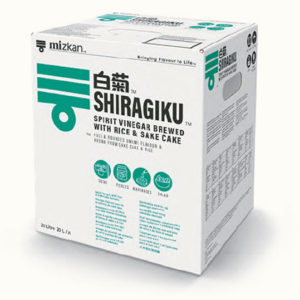12th August, 2021

Mizkan Shiragiku vinegar is popular among chefs in many high-end sushi restaurants because of its distinct taste which is hard to achieve through any other vinegar. This premium product is specially crafted to bring an umami taste to a variety of Japanese dishes.
However, it can also be used within other cuisines. Whether you’re wanting to add a unique flavour into Latin American, European or Arab dishes – Shiragiku’s versatility will not disappoint you. So, let’s discover exactly what Shiragiku is, how it is brewed and what makes it so special.
What is Shiragiku?
Shiragiku is a spirit vinegar launched in Japan in 1951, the product contains alcohol and is brewed with extracts from rice and ‘sake cake lees’ (which is residue left over from the sake brewing process) to achieve a perfectly balanced umami taste.
After trialling the seasoning with various foods and dishes, Mizkan concluded that the mellow acidity of the alcohol made from rice and the richness of the sake cake complemented sushi rice and their toppings better than the traditional rice vinegars.
Shiragiku gained immense popularity across Japanese restaurants due to its sweet and rich umami tang that enhances the already existing flavour of any dish.
Shiragiku ingredients
Shiragiku, which contains 8% alcohol, is composed of five main ingredients: water, alcohol made from rice, spirit vinegar, rice and sake cake extract. The latter is what differentiates Shiragiku from all other vinegars.
Alcohol making process
Koji rice is boiled to release starches which are fermented using yeast. This results in sugar which is further fermented into alcohol.
Sake cake lees
Sake cake lees are an outcome of the Japanese sake (national alcoholic beverage) making process. During the brewing process, fermented rice mash is compressed – this expresses the sake from the mash and the residue left is called sake lees.
Shiragiku brewing process
The Shiragiku brewing process involves lees left over from the sake brewing process being aged until they get a brownish colour. The sake cake lees and rice extracts are then added to alcohol, followed by acetic acid fermentation.
Shiragiku uses
Although known for complementing sushi rice, Shiragiku can be used with almost any dish from Japanese to European cuisine, here is how the vinegar can be used:
Shiragiku recipes
Alt text: Black belly pork and pickled apple slices with Shiragiku
We have a variety of recipes from experienced chefs that have used Shiragiku vinegar – from pokes to sauces, you can find a mix of classic Japanese dishes and tasty fusion recipes.
Wondering where to start? Here are Mizkan Chef’s favourite recipes that will awake your taste buds:
Vinegared Black Belly Pork & Pickled Apple Slice – this easy-to-make recipe takes around 2 hours and 30 minutes to cook and serves 4 people. Shiragiku vinegar is used as a marinade alongside other ingredients to add an umami flavour to the pork and to tenderise the meat.
Osechi Ryori – Salmon Kombu Roll – this traditional Japanese dish, served on New Year’s Day as part of the osechi ryori feast to welcome the new year, only takes around 30 minutes to cook.
Each Osechi Ryori ingredient is carefully selected for its symbolism that carries optimistic meaning in the new year. In this case, eating kombu is believed to bring happiness for the new year.
Mizkan’s Shiragiku vinegar is used as a seasoning towards the end of the cooking process – the vinegar is added into the kombu dashi (Japanese stock soup) alongside other ingredients and left to cook for 5 minutes before turning the heat off and letting it sit for about an hour before being served.
From the unique ingredient that makes Shiragiku what it is today to its adaptability to any dish – the art of crafting Shiragiku cannot be undermined. Try the vinegar yourself with any sweet or savoury Japanese or European recipe and explore the distinct taste Shiragiku vinegar brings to your dishes.
You can get the product by contacting us or, for the latest chef news, recipes and trends within the food industry sign up to our newsletter.

